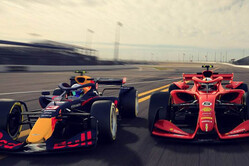 F1 technical boss, Ross Brawn has dismissed claims that the regulations being planned for the sport post-2020 will lead to the cars all looking pretty much the same - a charge that many might feel is already the case.
F1 technical boss, Ross Brawn has dismissed claims that the regulations being planned for the sport post-2020 will lead to the cars all looking pretty much the same - a charge that many might feel is already the case.
In its bid to level the playing field, other than increasing the number of standardised parts, not to mention the introduction of a budget cap, the planned "very prescriptive" regulations will strictly limit those areas in which teams can at present 'do their own thing', leaving some concerned that there will be no individuality in terms of design.
"We have been very prescriptive to begin with," said F1 MD, Ross Brawn at a presentation where the blueprint for the sport's future post-2020 was unveiled, "because if we are not we will not achieve the objectives.
"There are complaints that all the cars are going to look the same and the other nonsense we have heard, so as an exercise, Pat took all the existing cars and took the livery off them and put them up on a wall. You could not tell the difference between the cars we have now once the colours are taken off them. You need to be an extreme geek to pick them out, and even within our office we managed to pick three out! So when you see the existing cars with the colours taken off, you wouldn't know."
Ironically, the sport appears to be severely restricting the very same ingenuity that led to Brawn's own team winning the world championship at its only attempt. Essentially, throwing the baby out with the bathwater in its determination to level the field.
"We know with these very prescriptive regulations, the fertile minds of F1 will come up with different solutions," he admitted. "They will be prescriptive because we have to make sure we achieve these objectives, but there is enough latitude there.
"Undoubtedly from the relative freedom that the teams have had so far, it is going to be frustrating," he agreed. "But if they can take the approach that 'these regulations are the same for everyone and they will do a better job than anyone else, we just won't be two seconds faster we will be two tenths faster', then that is what we want in F1."
The FIA's head of single-seater technical matters says that while engineers have perhaps been most vocal in their complaints about the plans, he thinks team principals are more open to the path that F1 is heading in.
"There are plenty of aspects that the teams are pushing back on," added Nikolas Tombazis, the FIA's head of single-seater technical matters, "especially depending on where on the starting grid they lie and that influences their positions.
"Also within teams, not everybody sees it the same way," he continued. "Sometimes you have the team principals who have an overall view of the situation and understand what we are doing, and then the engineers who see that some of the freedom or playground will be reduced and therefore object.
"If you take the aero part of this study, a lot of this is focused on reducing the ability of teams to control the front wheel wake: that is a key part of this work," he added. "The ability to control front wheel wake is maybe one of the greatest challenges of the current aerodynamicists and reducing that creates this kick back."
However, Tombazis was keen to make clear that where teams have expressed doubts as to areas of the intended rules that they feel won't work, both the FIA and F1 has listened.
"We have taken a lot of comments into account and have been discussing this with teams over a long period," he said, which uncannily echoes the response of the official F1 Help channel over race weekends as fans vent their frustration over the numerous issues they face with the various official apps and streaming service, "and sometimes we have realised that certain things we were planning to do are wrong and we have changed and we have taken them into account.
"We have to be selective in our judgement," he concluded. "When we see the teams' comments are genuine and not because they want to preserve a certain advantage but are highlighting a weakness of what we are doing, we are open enough to admit we made a mistake and go back on it."






















sign in